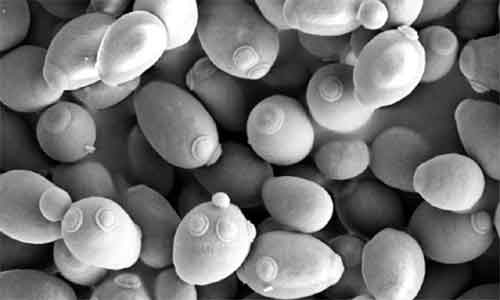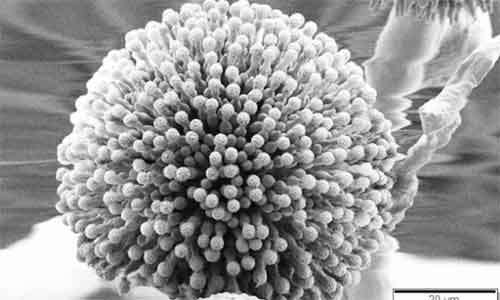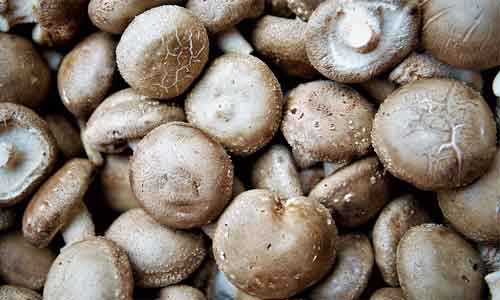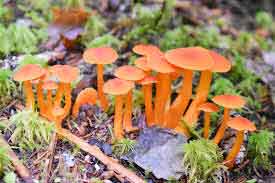Fungi (singular fungus) are the eukaryotic organisms that belong to the Kingdom Fungi. They have no chlorophyll pigments and vascular tissues. The body consists of a single cell to branched filamentous hyphae that often produce specialized fruiting bodies. The special characteristic of fungi is that they grow rapidly and die soon. In nature, there are over a million species of fungi, but only 10% of known fungi species are found in the scientific literature. There are over 300 species of fungi that are infectious to humans. Each year 85 billion tons of CO2 released in air through decomposing plants done by fungi. They are widely distributed organisms with excellent medical and environmental value.
Most of the fungi freely live in soil or water, but many form symbiotic or parasitic relationships with animals and plants. When they make a symbiotic relationship with the roots of plants, then it is known as mycorrhizal fungi. The study of fungi in a discipline of botany is called Mycology. Edible mushrooms, yeasts, rusts, smuts, mildews, black mold, toadstools, and the Penicillium notatum, which produce the antibiotic drug, penicillin, all belong to the domain Eukaryota under the kingdom Fungi.
You might also read: Virus : Definition, Characteristics and Classification
Characteristic Features of Fungi
- They are unicellular or multicellular eukaryotic organisms.
- The multicellular body is filamentous like, and it is composed of individual microscopic filament, which is known as hyphae. In this case, hyphae show apical growth and branches to produce lots of hyphae network, known as mycelium.
- They are saprophytic, symbiotic, or parasitic organisms.
- They get their nutrition through the process of absorption.
- They cannot make food through photosynthesis due to a lack of chlorophyll pigments.
- Primarily, the cell wall composed of chitin and glucagon, but in some species such as Oomycetes, the cell wall contains cellulose.
- Typically, they have a haploid nucleus, but hyphal components are multinucleated. In some species, such as Oomycota and some yeast, have diploid nuclei.
- The body of fungi can store trehalose, glycogen, sugar alcohols, and lipids.
- They can produce spores by sexual and asexual reproduction. In this case, sexual spores are Zygospores, Oospores, Ascospores, Basidiospores, etc. and asexual spores are Zoospores, Aplanospores, Sporangiospores, Conidia, etc.
- They are typically non-motile and have no embryonic stage.
- In the life cycle of the fungus, the phenomenon of alteration of generation occurs. In this case, they show both haploid and diploid stages.
- They are heterotrophic organisms, and they get their food from organic substances, animal, and plant matters.
- Fungi can tolerate acidic pH and prefer to grow in an acidic environment.
- Optimum growth temperature for most saprophytic fungi is 20-30°C, and a parasitic fungus is 30-37°C.Fungus shows a slower growth rate than that of bacteria.
- Fungi can live a dry environment and tolerate high sugar concentration.
Types of Fungi
Based on their structure, commonly, the following three types of fungi are seen within the fungi kingdom.
- 1. Yeasts
- 2. Molds and
- 3. Mushrooms
1. Yeasts
- They are eukaryotic, unicellular microorganisms.
- About 1500 species of yeasts are currently described, which constitute 1% of all described fungal species.
- . In nature, the sizes of the species vary, which can grow up to 40 µm in diameter.
- Most of the yeasts species reproduce asexually by mitosis, and some by budding.
- The best growth temperature for yeast species varies greatly. The best growth temperature for Saccharomyces telluris is ranged from 41 to 95 °F (5 to 35 °C), for Leucosporidium frigidum is 28 to 68 °F (−2 to 20 °C), and for Candida slooffi, it is ranged from 82 to 113 °F ( 28 to 45 °C).
- Some yeast species have a beneficial role, and some have harmful effects on human health. For example, Saccharomyces cerevisiae, is also known as Brewer’s or baker’s yeast, which is commercially used to produce bread in the food factory. In many cases, Saccharomyces boulardii is found in the intestine as normal flora. It is also found in the mouth and esophagus. It can become infectious due to weak immunity system.

2. Molds
- Molds are multicellular organisms with different colors, including green, gray, or black.
- Over 100,000 mold species have been identified.
- They have negative health effects on human health.
- They are found throughout the environment. Naturally, they inhabit the soil and break down decaying vegetable matters.
- They can rot leaves, wood, and other organic debris to form humus in the soil. They also spoil food and animal feed materials.
- They reproduce by creating spores which vary in shape that range from 2 to 100 µm in size. Spores of mold spread through the air, water, or on animals and can cause health issues by triggering allergies to humans.
Mold Types
Generally, mold species are grouped into the following three types:
1.Allergenic:Aspergillus, Cladosporium, and some Penicillium species produce airborne spores that can act as allergens. Other common molds that can also act as allergens include Helminthosporium, Mucor, Epicoccum, Rhizopus, Fusarium, and Pullularia, etc.
2.Pathogenic:Aspergillus fumigatus and Aspergillus flavus are the leading cause of invasive aspergillosis. It can also cause chronic pulmonary infections. Other pathogenic species, Histoplasma capsulatum causes infectious disease to human, which is known as histoplasmosis.
3.Toxigenic: Some mold species are toxic to humans and other animals that come in contact with them. Some toxigenic molds are Fusarium solani, Fusarium oxysporum, Fusarium moniliforme, Penicillium brevicompactum, Penicillium chrysogenum, Penicillium citrinum, Penicillium corylophilum, Penicillium cyclopium, Penicillium expansum. Penicillium fellutanum, Penicillium spinulosum, Penicillium viridicatum, Aspergillus versicolor, Aspergillus niger, Aspergillus flavusand and Stachybotrys chartarum.

3. Mushrooms
The term “mushroom” is derived from the French word ‘mousseron’ meaning moss. It belongs to the order Agaricales of Phylum Basidiomycota. There are different types of mushroom, among them, some are edible, some may be poisonous, or unpalatable. Mushroom is also known as toadstool, which grows on soil and trees. They have fleshy, spore-bearing, and umbrella-shaped fruiting bodies. On the planet, mushrooms are one of the most health-promoting superfoods which have more than 100 different beneficial effects on health. It is used for improving overall health by preventing and treating serious health conditions.

Edible Mushromms
Mushrooms offer commercial, aesthetic, and ecological values. Edible mushroom varieties are tasty, and they supply vitamin B and minerals such as phosphorus, potassium, iron, and selenium with low calories. Some mushrooms show diverse forms and colors and exhibit wondrous nature for humans.
Mushrooms make an important source of nutrition and energy in terrestrial food chains because many animals like rodents and birds also eat mushrooms. Besides these, mushrooms also contain toxic substances, which can cause human sickness or even death. The most deadly mushrooms are the angel and the death cap, which belong to the genus Amanita.
Economic Roles of Fungi
Beneficial Roles of Fungi
Fungi show the following both ecological and economic roles:
- Fungi play an important role in our environment. They are used in the food factory for the production of bakeries and breweries. They are also used in food processing and in pharmaceutical industries.
- Fungi also exhibit a symbiotic relationship with a large range of organisms. The symbiotic relationship helps in the absorption and retention of moisture. Some fungi live in the roots of some plants, which help the plants to take up nutrients from the soil. This relationship is known as a mycorrhizal association.
- Fungi play an important role in to recycle nutrients and decompose of plant debris.
- Some fungi inhabit the soil that has a beneficial effect on commercial agriculture. In this case, fungi help to increase soil fertility.
- Saprophytic fungi inhabit in acidic soils which decay and decompose dead plants and their waste.
- They break down organic materials and continue the recycles of nutrients through the ecosystem.
- Symbiotic fungus inhabits in the roots of the many vascular plants and supplies essential nutrients.
- Many fungi species, such as Agaricus volvarella, Morchella, are used as human food.
- Many fungi species such as Penicilium notatum, Penicilium chrysogenum are used to produce the antibiotic drug, penicillin. The anti-fungal drug is also produced from Penicillium griseofulvum. Some fungi are used in the production of vitamins such as riboflavin, and various important drugs such as ergotamine and cortisone.
- Many fungi species take part in the elimination of various diseases like malaria. Some fungi species attack harmful insects that can cause crop disease, and in such a way, they play an important role in the enrichment of the economy.
- Many fungi species (such as Ascherronia deyroides, Beauveria bassiana, Isara ferinosa, Empusa sepulchralis) act as bio-controlling agents. In this case, they are used for controlling insect pests of crops.
- The yeasts are used as important model organisms for studying problems in molecular biology and genetics. Many varieties of Saccharomyces cerevisiae, such as AH109, PJ69-4 alpha, Y187, etc. are used for higher research in molecular biology.
- Many fungal species such as Aspergillus, Penicillium, Saccharomyces are used extensively for producing important industrial products such as gluconic, citric, formic acid, lactic, and malic acids.
- Some fungi are used to produce certain types of cheese and soft drinks.
- Saccharomyces cerevisiae is known as baker`s yeast. It is used to make commercially baked bread, cakes, etc.
- Alcoholic beverage products are also produced from Saccharomyces sp. through fermentation.
- Blue cheeses like Roquefort, gorgonzola, Danish blue, etc are produced from Penicilium camemberti, and Penicilium rosqueferti.
- Fungi also have a great source of food. They are a rich source of protein and vitamins with excellent flavor. Besides these, some fungi (mushrooms) are deadly poisonous and cause even death.
- Many fungi species act as a good source of enzymes like lipase, amylase, cellulases, invertages, proteases, etc. Besides these, they provide an important source of plant hormones like Gibberella fujikuroi
Harmful Roles of Fungi
- Many fungi species cause diseases in humans. Some fungal species such as Aspergillus niger, Aspergillus fumigates act as common human pathogens, and they cause diseases like aspergillosis of the throat, bronchi of lungs, and well-known skin disease “ringworm“. Some species produce mycotoxins and affect human health in various ways.
- Some species of fungus such as Aspergillus, Mucor, Rhizopus, etc. can cause domestic animal diseases.
- Some fungi affect commercial agriculture and cause different diseases both in crops and animals, which results in economic losses. The most common and significant crop diseases are: potato blight, Downy mildews of grapes, Ergot disease of rye, Apple scab, Rust diseases, Blackarm, wilt and root rot of cotton, rusts, root and stem rots, brown leaf spot disease of rice, etc.
- Fungi also release toxic substances that destroy the plasma membrane of the liver cells and also cause kidney and intestine diseases.
- Many species of fungi spoil food materials if the food does not properly store. In this case, Aspergillus, Rhizopus, Mucor, yeasts, Penicillium, etc. damage many food items, such as fruit, fruit-derived food, cooked food, bread, fish and meats, sweetmeats, etc.
- Many personal commodities such as paper, books, wearing clothes, leather goods, camera, microscope, television, radio, electric wearing, wood, and furniture, etc. are destroyed by many fungal species.
Concluding Remarks
Fungi are the eukaryotic organisms that have a great role in our economy. They have both beneficial and harmful effects in our daily life. They take part in the decomposing of organic material to form the humus. They also involve in the recycling process and release nutritional elements in the soils, which are essential for the growth of plants. Besides these, many fungi are used as a research tool in the study of fundamental biological processes.

